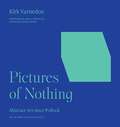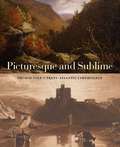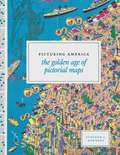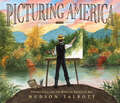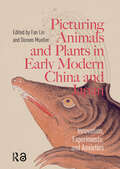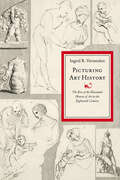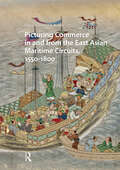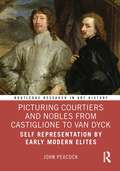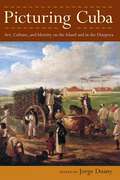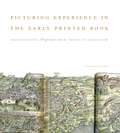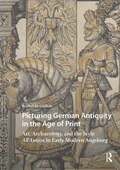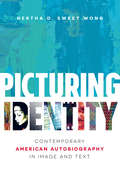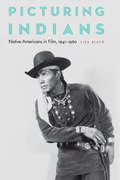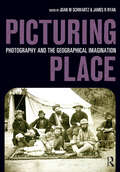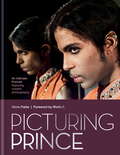- Table View
- List View
Pictures of Nothing: Abstract Art since Pollock (The A. W. Mellon Lectures in the Fine Arts #48)
by Kirk VarnedoeAn illuminating exploration of the meaning of abstract art by acclaimed art historian Kirk Varnedoe"What is abstract art good for? What's the use—for us as individuals, or for any society—of pictures of nothing, of paintings and sculptures or prints or drawings that do not seem to show anything except themselves?" In this invigorating account of abstract art since Jackson Pollock, eminent art historian Kirk Varnedoe, the former chief curator of painting and sculpture at the Museum of Modern Art, asks these and other questions as he frankly confronts the uncertainties we may have about the nonrepresentational art produced in the past five decades. He makes a compelling argument for its history and value, much as E. H. Gombrich tackled representation fifty years ago in Art and Illusion, another landmark A. W. Mellon Lectures volume. Realizing that these lectures might be his final work, Varnedoe conceived of them as a statement of his faith in modern art and as the culminating example of his lucidly pragmatic and philosophical approach to art history. He delivered the lectures, edited and reproduced here with their illustrations, to overflowing crowds at the National Gallery of Art in Washington in the spring of 2003, just months before his death.With brilliance, passion, and humor, Varnedoe addresses the skeptical attitudes and misunderstandings that we often bring to our experience of abstract art. Resisting grand generalizations, he makes a deliberate and scholarly case for abstraction—showing us that more than just pure looking is necessary to understand the self-made symbolic language of abstract art. Proceeding decade by decade, he brings alive the history and biography that inform the art while also challenging the received wisdom about distinctions between abstraction and representation, modernism and postmodernism, and minimalism and pop. The result is a fascinating and ultimately moving tour through a half century of abstract art, concluding with an unforgettable description of one of Varnedoe's favorite works.Please note: All images in this ebook are presented in black and white and have been reduced in size.
Pictures of Poverty: The Works of George R. Sims and Their Screen Adaptations (Kintop Studies In Early Cinema Ser.)
by Lydia JakobsFrom Charles Dickens's Oliver Twist to George Sims's How the Poor Live, illustrated accounts of poverty were en vogue in Victorian Britain. Poverty was also a popular subject on the screen, whether in dramatic retellings of well-known stories or in 'documentary' photographs taken in the slums. London and its street life were the preferred setting for George Robert Sims's rousing ballads and the numerous magic lantern slide series and silent films based on them. Sims was a popular journalist and dramatist, whose articles, short stories, theatre plays and ballads discussed overcrowding, drunkenness, prostitution and child poverty in dramatic and heroic episodes from the lives and deaths of the poor. Richly illustrated and drawing from many previously unknown sources, Pictures of Poverty is a comprehensive account of the representation of poverty throughout the Victorian period, whether disseminated in newspapers, illustrated books and lectures, presented on the theatre stage or projected on the screen in magic lantern and film performances. Detailed case studies reveal the intermedial context of these popular pictures of poverty and their mobility across genres. With versatile author George R. Sims as the starting point, this study explores the influence of visual media in historical discourses about poverty and the highly controversial role of the Victorian state in poor relief.
Picturesque And Sublime: Thomas Cole's Trans-atlantic Inheritance
by Jennifer Raab Gillian Forrester Tim BarringerLandscape art in the early 19th century was guided by two rival concepts: the picturesque, which emphasized touristic pleasures and visual delight, and the sublime, an aesthetic category rooted in notions of fear and danger. British artists including J.M.W. Turner and John Constable raised landscape painting to new heights and their work reached global audiences through the circulation of engravings. Thomas Cole, born in England, emigrated to the United States in 1818, and first absorbed the picturesque and sublime through print media. Cole transformed British and continental European traditions to create a distinctive American form of landscape painting. The authors here explore the role of prints as agents of artistic transmission and look closely at how Cole's own creative process was driven by works on paper such as drawings, notebooks, letters, and manuscripts. Also considered is the importance of the parallel works of William Guy Wall, best known for his pioneering Hudson River Portfolio. Beautifully illustrated with works on paper ranging from watercolors to etchings, mezzotints, aquatints, engravings, and lithographs, as well as notable paintings, this book offers important insights into Cole's formulation of a profound new category in art--the American sublime.
Picturing America: The Golden Age of Pictorial Maps
by Stephen J. HornsbyInstructive, amusing, colorful—pictorial maps have been used and admired since the first medieval cartographer put pen to paper depicting mountains and trees across countries, people and objects around margins, and sea monsters in oceans. More recent generations of pictorial map artists have continued that traditional mixture of whimsy and fact, combining cartographic elements with text and images and featuring bold and arresting designs, bright and cheerful colors, and lively detail. In the United States, the art form flourished from the 1920s through the 1970s, when thousands of innovative maps were mass-produced for use as advertisements and decorative objects—the golden age of American pictorial maps. Picturing America is the first book to showcase this vivid and popular genre of maps. Geographer Stephen J. Hornsby gathers together 158 delightful pictorial jewels, most drawn from the extensive collections of the Library of Congress. In his informative introduction, Hornsby outlines the development of the cartographic form, identifies several representative artists, describes the process of creating a pictorial map, and considers the significance of the form in the history of Western cartography. Organized into six thematic sections, Picturing America covers a vast swath of the pictorial map tradition during its golden age, ranging from “Maps to Amuse” to “Maps for War.” Hornsby has unearthed the most fascinating and visually striking maps the United States has to offer: Disney cartoon maps, college campus maps, kooky state tourism ads, World War II promotional posters, and many more. This remarkable, charming volume’s glorious full-color pictorial maps will be irresistible to any map lover or armchair traveler.
Picturing America: Thomas Cole and the Birth of American Art
by Hudson TalbottThis fascinating look at artist Thomas Cole's life takes readers from his humble beginnings to his development of a new painting style that became America's first formal art movement: the Hudson River school of painting.Thomas Cole was always looking for something new to draw. Born in England during the Industrial Revolution, he was fascinated by tales of the American countryside, and was ecstatic to move there in 1818. The life of an artist was difficult at first, however Thomas kept his dream alive by drawing constantly and seeking out other artists. But everything changed for him when he was given a ticket for a boat trip up the Hudson River to see the wilderness of the Catskill Mountains. The haunting beauty of the landscape sparked his imagination and would inspire him for the rest of his life. The majestic paintings that followed struck a chord with the public and drew other artists to follow in his footsteps, in the first art movement born in America. His landscape paintings also started a conversation on how to protect the country's wild beauty. Hudson Talbott takes readers on a unique journey as he depicts the immigrant artist falling in love with--and fighting to preserve--his new country.
Picturing American Modernity: Traffic, Technology, and the Silent Cinema
by Kristen WhisselIn Picturing American Modernity, Kristen Whissel investigates the relationship between early American cinema and the experience of technological modernity. She demonstrates how between the late 1890s and the eve of the First World War moving pictures helped the U. S. public understand the possibilities and perils of new forms of "traffic" produced by industrialization and urbanization. As more efficient ways to move people, goods, and information transformed work and leisure at home and contributed to the expansion of the U. S. empire abroad, silent films presented compelling visual representations of the spaces, bodies, machines, and forms of mobility that increasingly defined modern life in the United States and its new territories. Whissel shows that by portraying key events, achievements, and anxieties, the cinema invited American audiences to participate in the rapidly changing world around them. Moving pictures provided astonishing visual dispatches from military camps prior to the outbreak of fighting in the Spanish-American War. They allowed audiences to delight in images of the Pan-American Exposition, and also to mourn the assassination of President McKinley there. One early film genre, the reenactment, presented spectators with renditions of bloody battles fought overseas during the Philippine-American War. Early features offered sensational dramatizations of the scandalous "white slave trade," which was often linked to immigration and new forms of urban work and leisure. By bringing these frequently distant events and anxieties "near" to audiences in cities and towns across the country, the cinema helped construct an American national identity for the machine age.
Picturing Animals and Plants in Early Modern China and Japan: Innovation, Experiments, and Anxieties
by Fan Lin Doreen MuellerThe seven articles in this edited volume address the complex meanings that visual representations of plants and animals gained in early modern China and Japan. They aim to understand animals and plants in the new contexts of empirical and epistemological concerns, political and social agendas, and cultural interests. In particular, they examine the ways in which scholars, professional painters, and publishers engendered the sociohistorical meanings of the images.
Picturing Art History: The Rise of the Illustrated History of Art in the Eighteenth Century
by Ingrid VermeulenBooks on art history are nearly always lavishly illustrated with quality colour reproductions of famous masterpieces. Yet this has not always been the case: it was only in the eighteenth century that art books came to be illustrated with beautiful images. Picturing Art History shows how the fundamentally new notion of the history of art as a visual history was responsible for this development. In the age before photography, paper collections of prints and drawings offered the only way to picture the artistic past. For the first time, illustrations became indispensable toolsas the new belief grew that art works rather than artists were the measure of the artistic past. Internationally renowned art scholars such as Bottari (1689-1775), Winckelmann (1717-1768) and d'Agincourt (1730-1814) collected reproductions in the form of prints and drawings, triggering discussions of the nature of illustrations as representations of art, classification of reproductions to demonstrate trends in art history, and the relationship between image and text in the art literature. With the help of illustrations, art history became an extraordinary visual experience, vital to the understanding of the history of art.
Picturing Casablanca: Portraits of Power in a Modern City
by Susan OssmanIn Picturing Casablanca, Susan Ossman probes the shape and texture of mass images in Casablanca, from posters, films, and videotapes to elections, staged political spectacles, and changing rituals. In a fluid style that blends ethnographic narrative, cultural reportage, and the author's firsthand experiences, Ossman sketches a radically new vision of Casablanca as a place where social practices, traditions, and structures of power are in flux.Ossman guides the reader through the labyrinthine byways of the city, where state bureaucracy and state power, the media and its portrayal of the outside world, and people's everyday lives are all on view. She demonstrates how images not only reflect but inform and alter daily experience. In the Arab League Park, teenagers use fashion and flirting to attract potential mates, defying traditional rules of conduct. Wedding ceremonies are transformed by the ubiquitous video camera, which becomes the event's most important spectator. Political leaders are molded by the state's adept manipulation of visual media.From Madonna videos and the TV's transformation of social time, to changing gender roles and new ways of producing and disseminating information, the Morocco that Ossman reveals is a telling commentary on the consequences of colonial planning, the influence of modern media, and the rituals of power and representation enacted by the state.
Picturing Commerce in and from the East Asian Maritime Circuits, 1550-1800 (Visual and Material Culture, 1300-1700)
by Tamara H. BentleyCombining strikingly new scholarship by art historians, historians, and ethnomusicologists, this interdisciplinary volume illuminates trade ties within East Asia, and from East Asia outwards, in the years 1550 to 1800. While not encyclopedic, the selected topics greatly advance our sense of this trade picture. Throughout the book, multi-part trade structures are excavated; the presence of European powers within the Asian trade nexus features as part of this narrative. Visual goods are highlighted, including lacquerwares, paintings, prints, musical instruments, textiles, ivory sculptures, unfired ceramic portrait figurines, and Chinese, Japanese, Korean, and Southeast Asian ceramic vessels. These essays underscore the significance of Asian industries producing multiples, and the rhetorical charge of these goods, shifting in meaning as they move. Everyday commodities are treated as well; for example, the trans-Pacific trade in contraband mercury, used in silver refinement, is spelled out in detail. Building reverberations between merchant networks, trade goods, and the look of the objects themselves, this richly-illustrated book brings to light the Asian trade engine powering the early modern visual cultures of East and Southeast Asia, the American colonies, and Europe.
Picturing Courtiers and Nobles from Castiglione to Van Dyck: Self Representation by Early Modern Elites (Routledge Research in Art History)
by John PeacockThis interdisciplinary study examines painted portraiture as a defining metaphor of elite self-representation in early modern culture. Beginning with Castiglione’s Book of the Courtier (1528), the most influential early modern account of the formation of elite identity, the argument traces a path across the ensuing century towards the images of courtiers and nobles by the most persuasive of European portrait painters, Van Dyck, especially those produced in London during the 1630s. It investigates two related kinds of texts: those which, following Castiglione, model the conduct of the ideal courtier or elite social conduct more generally; and those belonging to the established tradition of debates about the condition of nobility –how far it is genetically inherited and how far a function of excelling moral and social behaviour. Van Dyck is seen as contributing to these discussions through the language of pictorial art. The book will be of interest to scholars working in art history, cultural history, early modern history and Renaissance studies.
Picturing Cuba: Art, Culture, and Identity on the Island and in the Diaspora
by Jorge DuanyPicturing Cuba explores the evolution of Cuban visual art and its links to cubanía, or Cuban cultural identity. Featuring artwork from the Spanish colonial, republican, and postrevolutionary periods of Cuban history, as well as the contemporary diaspora, these richly illustrated essays trace the creation of Cuban art through shifting political, social, and cultural circumstances. Contributors examine colonial-era lithographs of Cuba’s landscape, architecture, people, and customs that portrayed the island as an exotic, tropical location. They show how the avant-garde painters of the vanguardia, or Havana School, wrestled with the significance of the island’s African and indigenous roots, and they also highlight subversive photography that depicts the harsh realities of life after the Cuban Revolution. They explore art created by the first generation of postrevolutionary exiles, which reflects a new identity—lo cubanoamericano, Cuban-Americanness—and expresses the sense of displacement experienced by Cubans who resettled in another country. A concluding chapter evaluates contemporary attitudes toward collecting and exhibiting post-revolutionary Cuban art in the United States. Encompassing works by Cubans on the island, in exile, and born in America, this volume delves into defining moments in Cuban art across three centuries, offering a kaleidoscopic view of the island’s people, culture, and history. Contributors: Anelys Alvarez | Lynnette M. F. Bosch | María A. Cabrera Arús | Iliana Cepero | Ramón Cernuda | Emilio Cueto | Carol Damian | Victor Deupi | Jorge Duany | Alison Fraunhar | Andrea O’Reilly Herrera | Jean-François Lejeune | Abigail McEwen | Ricardo Pau-Llosa | E. Carmen Ramos
Picturing Dogs, Seeing Ourselves: Vintage American Photographs (Animalibus: Of Animals and Cultures #4)
by Ann-Janine MoreyDogs are as ubiquitous in American culture as white picket fences and apple pie, embracing all the meanings of wholesome domestic life—family, fidelity, comfort, protection, nurturance, and love—as well as symbolizing some of the less palatable connotations of home and family, including domination, subservience, and violence. In Picturing Dogs, Seeing Ourselves, Ann-Janine Morey presents a collection of antique photographs of dogs and their owners in order to investigate the meanings associated with the canine body. Included are reproductions of 115 postcards, cabinet cards, and cartes de visite that feature dogs in family and childhood snapshots, images of hunting, posed studio portraits, and many other settings between 1860 and 1950. These photographs offer poignant testimony to the American romance with dogs and show how the dog has become part of cultural expressions of race, class, and gender.Animal studies scholars have long argued that our representation of animals in print and in the visual arts has a profound connection to our lived cultural identity. Other books have documented the depiction of dogs in art and photography, but few have reached beyond the subject’s obvious appeal. Picturing Dogs, Seeing Ourselves draws on animal, visual, and literary studies to present an original and richly contextualized visual history of the relationship between Americans and their dogs. Though the personal stories behind these everyday photographs may be lost to us, their cultural significance is not.
Picturing Ecology: Photography and the birth of a new science
by Damian HughesThis book examines the role of photography and visual culture in the emergence of ecological science between 1895 and 1939.
Picturing Experience in the Early Printed Book: Breydenbach’s Peregrinatio from Venice to Jerusalem
by Elizabeth RossBernhard von Breydenbach’s Peregrinatio in terram sanctam (Journey to the Holy Land), first published in 1486, is one of the seminal books of early printing and is especially renowned for the originality of its woodcuts. In Picturing Experience in the Early Printed Book, Elizabeth Ross considers the Peregrinatio from a variety of perspectives to explain its value for the cultural history of the period. Breydenbach, a high-ranking cleric in Mainz, recruited the painter Erhard Reuwich of Utrecht for a religious and artistic adventure in a political hot spot—a pilgrimage to research the peoples, places, plants, and animals of the Levant. The book they published after their return ambitiously engaged with the potential of the new print medium to give an account of their experience.The Peregrinatio also aspired to rouse readers to a new crusade against Islam by depicting a contest in the Mediterranean between the Christian bastion of the city of Venice and the region’s Muslim empires. This crusading rhetoric fit neatly with the state of the printing industry in Mainz, which largely subsisted as a tool for bishops’ consolidation of authority, including selling the pope’s plans to combat the Ottoman Empire.Taking an artist on such an enterprise was unprecedented. Reuwich set a new benchmark for technical achievement with his woodcuts, notably a panorama of Venice that folds out to 1.62 meters in length and a foldout map that stretches from Damascus to Sudan around the first topographically accurate view of Jerusalem. The conception and execution of the Peregrinatio show how and why early printed books constructed new means of visual representation from existing ones—and how the form of a printed book emerged out of the interaction of eyewitness experience and medieval scholarship, real travel and spiritual pilgrimage, curiosity and fixed belief, texts and images.
Picturing Experience in the Early Printed Book: Breydenbach’s Peregrinatio from Venice to Jerusalem
by Elizabeth RossBernhard von Breydenbach’s Peregrinatio in terram sanctam (Journey to the Holy Land), first published in 1486, is one of the seminal books of early printing and is especially renowned for the originality of its woodcuts. In Picturing Experience in the Early Printed Book, Elizabeth Ross considers the Peregrinatio from a variety of perspectives to explain its value for the cultural history of the period. Breydenbach, a high-ranking cleric in Mainz, recruited the painter Erhard Reuwich of Utrecht for a religious and artistic adventure in a political hot spot—a pilgrimage to research the peoples, places, plants, and animals of the Levant. The book they published after their return ambitiously engaged with the potential of the new print medium to give an account of their experience.The Peregrinatio also aspired to rouse readers to a new crusade against Islam by depicting a contest in the Mediterranean between the Christian bastion of the city of Venice and the region’s Muslim empires. This crusading rhetoric fit neatly with the state of the printing industry in Mainz, which largely subsisted as a tool for bishops’ consolidation of authority, including selling the pope’s plans to combat the Ottoman Empire.Taking an artist on such an enterprise was unprecedented. Reuwich set a new benchmark for technical achievement with his woodcuts, notably a panorama of Venice that folds out to 1.62 meters in length and a foldout map that stretches from Damascus to Sudan around the first topographically accurate view of Jerusalem. The conception and execution of the Peregrinatio show how and why early printed books constructed new means of visual representation from existing ones—and how the form of a printed book emerged out of the interaction of eyewitness experience and medieval scholarship, real travel and spiritual pilgrimage, curiosity and fixed belief, texts and images.
Picturing German Antiquity in the Age of Print: Art, Archaeology, and the Style All’Antica in Early Modern Augsburg (Visual and Material Culture, 1300-1700)
by Rachel CarlislePicturing German Antiquity in the Age of Print: Art, Archaeology, and the Style All'antica in Early Modern Augsburg examines the central role of print to local antiquarian pursuits and generation of a style all'antica in early sixteenth-century Augsburg, Germany. Working in the shadow of Holy Roman Emperor Maximilian I, Augsburg's leading patrons, including humanist Konrad Peutinger and the mercantile Fugger family, documented local antiquities and commissioned new works of classicizing art and architecture, visually asserting a genuine, unbroken lineage to the city's past. This study challenges earlier narratives by arguing that Augsburg's artists and printers did not directly copy Italian Renaissance models but instead manipulated the imported visual vocabulary according to local concerns. The book brings together scholarly discourses on transalpine exchange, scientific advancements in printmaking, and reception of antiquity north of the Alps to offer a new understanding of art in early modern Augsburg and northern Europe at large.
Picturing History at the Ottoman Court
by Emine Fetvaci“A comprehensive study of Ottoman illuminated histories and their readers, makers, intended meanings and political uses.” —Bulletin of the School of Oriental and African StudiesThe Ottoman court of the late sixteenth century produced an unprecedented number of sumptuously illustrated chronicles. While usually dismissed as imperial eulogies, Emine Fetvaci demonstrates that these books commented on contemporary events, promoted the political agendas of courtiers as well as the sultan, and presented their patrons and creators in ways that helped shape the perspectives of their elite audience. Picturing History at the Ottoman Court traces the simultaneous crafting of political power, the codification of a historical record, and the unfolding of cultural change.“An absolutely original work, full of good ideas and important points. Fascinating.” —Pamela Brummett, University of Tennessee“One of the most profound examples of new directions in scholarship dealing with “the book” and “the text” of the past few decades. It shows an exceptional breadth of vision.” —Walter G. Andrews, University of Washington“[Fetvaci’s] book, an exhaustive and richly illustrated study based on secondary literature and primary sources, among them some documents in the Topkapi Palace archive, will no doubt remain the standard study on the topic for many years to come.” —Bibliotheca Orientalis“A welcome addition to the work of scholars who are studying these manuscripts in relation to the context of their production. This is a handsome book.” —International Journal of Islamic Architecture“This is a book for the specialist as well as the intelligent undergraduate, as its exceptional clarity of organization and exposition makes complex and overlapping dynamics readily meaningful. The lavish illustration (102 colour plates) and the author’s interest in comparative imperial practices add to its depth.” —*Bulletin of the School of Oriental and African Studies
Picturing Identity: Contemporary American Autobiography in Image and Text
by Hertha D. WongIn this book, Hertha D. Sweet Wong examines the intersection of writing and visual art in the autobiographical work of twentieth- and twenty-first-century American writers and artists who employ a mix of written and visual forms of self-narration. Combining approaches from autobiography studies and visual studies, Wong argues that, in grappling with the breakdown of stable definitions of identity and unmediated representation, these writers-artists experiment with hybrid autobiography in image and text to break free of inherited visual-verbal regimes and revise painful histories. These works provide an interart focus for examining the possibilities of self-representation and self-narration, the boundaries of life writing, and the relationship between image and text. Wong considers eight writers-artists, including comic-book author Art Spiegelman; Faith Ringgold, known for her story quilts; and celebrated Indigenous writer Leslie Marmon Silko. Wong shows how her subjects formulate webs of intersubjectivity shaped by historical trauma, geography, race, and gender as they envision new possibilities of selfhood and fresh modes of self-narration in word and image.
Picturing Illinois: Twentieth-Century Postcard Art from Chicago to Cairo
by Keith A. Sculle John A. JakleThe American picture postcard debuted around the start of the twentieth century, creating an enthusiasm for sending and collecting postcard art that continued for decades. As a form of popular culture, scenic postcards strongly influenced how Americans conceptualized both faraway and nearby places through portrayals of landscapes, buildings, and historic sites. In this gloriously illustrated history of the picture postcard in Illinois, John A. Jakle and Keith A. Sculle study a rich and diverse set of images that chronicle what Illinoisans considered attractive, intriguing, and memorable. They also discuss how messages written on postcards reveal the sender's personal interpretation of local geography and scenery. The most popularly depicted destination was Chicago, America's great boomtown.Its portraits are especially varied, showing off its high-rise architecture, its teeming avenues, and the vitality of its marketplaces and even slaughterhouses. Postcards featuring downstate locales, however, elaborated and reinforced stereotypes that divided the state, portraying the rest of Illinois as the counterpoint to Chicago's urban bustle. Scores of cards from Springfield, Peoria, Bloomington-Normal, Urbana-Champaign, Quincy, and Vandalia emphasize wide-open prairies, modest civic edifices, and folksy charm. The sense of dichotomy between Chicago and the rest of Illinois was, of course, a substantial fallacy, since the city's very prosperity depended upon the entire state's fertile farmlands, natural resources, and small industries. Jakle and Sculle follow this dialogue between urban Chicago and rural downstate as it is illustrated on two hundred vintage postcards, observing both their common conventions and their variety. They also discuss the advances in printing technology in the early 1900s that made mass appeal possible. Providing rich historical and geographical context, Picturing Illinois: Twentieth-Century Postcard Art from Chicago to Cairo illustrates the picture postcard's significance in American popular culture and the unique ways in which Illinoisans pictured their world.
Picturing Imperial Power: Colonial Subjects in Eighteenth-Century British Painting
by Beth Fowkes TobinThis study of colonialism and art examines the intersection of visual culture and political power in late-eighteenth-century British painting. Focusing on paintings from British America, the West Indies, and India, Beth Fowkes Tobin investigates the role of art in creating and maintaining imperial ideologies and practices--as well as in resisting and complicating them. Informed by the varied perspectives of postcolonial theory, Tobin explores through close readings of colonial artwork the dynamic middle ground in which cultures meet. Linking specific colonial sites with larger patterns of imperial practice and policy, she examines paintings by William Hogarth, Benjamin West, Gilbert Stuart, Arthur William Devis, and Agostino Brunias, among others. These works include portraits of colonial officials, conversation pieces of British families and their servants, portraits of Native Americans and Anglo-Indians, and botanical illustrations produced by Calcutta artists for officials of the British Botanic Gardens. In addition to examining the strategies that colonizers employed to dominate and define their subjects, Tobin uncovers the tactics of negotiation, accommodation, and resistance that make up the colonized's response to imperial authority. By focusing on the paintings' cultural and political engagement with imperialism, she accounts for their ideological power and visual effect while arguing for their significance as agents in the colonial project. Pointing to the complexity, variety, and contradiction within colonial art, Picturing Imperial Power contributes to an understanding of colonialism as a collection of social, economic, political, and epistemological practices that were not monolithic and inevitable, but contradictory and contingent on various historical forces. It will interest students and scholars of colonialism, imperial history, postcolonial history, art history and theory, and cultural studies.
Picturing Indians: Native Americans in Film, 1941-1960
by Liza BlackStanding at the intersection of Native history, labor, and representation, Picturing Indians presents a vivid portrait of the complicated experiences of Native actors on the sets of midcentury Hollywood Westerns. This behind-the-scenes look at costuming, makeup, contract negotiations, and union disparities uncovers an all-too-familiar narrative of racism and further complicates filmmakers&’ choices to follow mainstream representations of &“Indianness.&” Liza Black offers a rare and overlooked perspective on American cinema history by giving voice to creators of movie Indians—the stylists, public relations workers, and the actors themselves. In exploring the inherent racism in sensationalizing Native culture for profit, Black also chronicles the little-known attempts of studios to generate cultural authenticity and historical accuracy in their films. She discusses the studios&’ need for actual Indians to participate in, legitimate, and populate such filmic narratives. But studios also told stories that made Indians sound less than Indian because of their skin color, clothing, and inability to do functions and tasks considered authentically Indian by non-Indians. In the ongoing territorial dispossession of Native America, Native people worked in film as an economic strategy toward survival. Consulting new primary sources, Black has crafted an interdisciplinary experience showcasing what it meant to &“play Indian&” in post–World War II Hollywood.
Picturing Place: Photography and the Geographical Imagination
by James R. Ryan Joan M. SchwartzThe advent of photography opened up new worlds to 19th century viewers, who were able to visualize themselves and the world beyond in unprecedented detail. But the emphasis on the photography's objectivity masked the subjectivity inherent in deciding what to record, from what angle and when. This text examines this inherent subjectivity. Drawing on photographs that come from personal albums, corporate archives, commercial photographers, government reports and which were produced as art, as record, as data, the work shows how the photography shaped and was shaped by geographical concerns.
Picturing Prince: An Intimate Portrait
by Steve ParkePICTURING PRINCE sees the late icon's former art director, STEVE PARKE, revealing stunning intimate photographs of the singer from his time working at Paisley Park. At least half of the images in the book are exclusively published here for the first time; most other images in the book are rare to the public eye.Alongside these remarkable images are fifty engaging, poignant and often funny written vignettes by Parke, which reveal the very human man behind the reclusive superstar: from shooting hoops to renting out movie theatres at 4am; from midnight requests for camels to meaningful conversations that shed light on Prince as a man and artist. STEVE PARKE started working with Prince in 1988, after a mutual friend showed Prince some of Steve's photorealistic paintings. He designed everything from album covers and merchandise to sets for Prince's tours and videos. Somewhere in all of this, he became Paisley Park's official art director. He began photographing Prince at the request of the star himself, and continued to do so for the next several years. The images in this book are the arresting result of this collaboration.
Picturing Prince: An Intimate Portrait
by Steve ParkePICTURING PRINCE sees the late icon's former art director, STEVE PARKE, revealing stunning intimate photographs of the singer from his time working at Paisley Park. At least half of the images in the book are exclusively published here for the first time; most other images in the book are rare to the public eye.Alongside these remarkable images are fifty engaging, poignant and often funny written vignettes by Parke, which reveal the very human man behind the reclusive superstar: from shooting hoops to renting out movie theatres at 4am; from midnight requests for camels to meaningful conversations that shed light on Prince as a man and artist. STEVE PARKE started working with Prince in 1988, after a mutual friend showed Prince some of Steve's photorealistic paintings. He designed everything from album covers and merchandise to sets for Prince's tours and videos. Somewhere in all of this, he became Paisley Park's official art director. He began photographing Prince at the request of the star himself, and continued to do so for the next several years. The images in this book are the arresting result of this collaboration.
